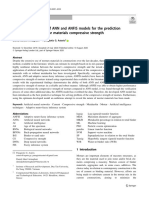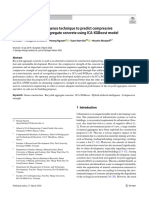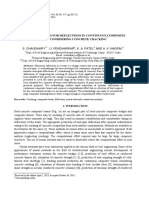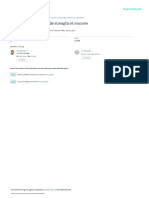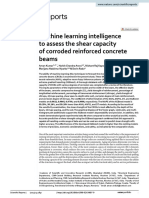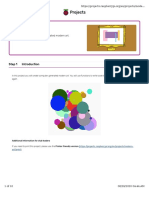Advances in Computational Design, Vol. 9, No.
4 (2024) 253-268
https://doi.org/10.12989/acd.2024.9.4.253 253
A streamlined deep-learning algorithm for predicting
the ultimate axial load of self-stressed columns
P. Krithika1a, P. Gajalakshmi2b and M.Y. Mohammed Asif2c
1
Department of Civil Engineering, SRM Institute of Science and Technology,
Kattankulathur, Chengalpattu, Tamil Nadu, India
2
Department of Civil Engineering, B.S. Abdur Rahman Crescent Institute of Science and Technology,
Vandalur, Chennai, Tamil Nadu, India
(Received May 3, 2024, Revised September 20, 2024, Accepted October 8, 2024)
Abstract. In light of their confinement effect, composite columns were frequently chosen in modern
construction procedures over reinforced concrete columns. The outer confining tube was made of various
materials, which are primarily distinguished through their mechanical characteristics. The fundamental
purpose of this research is to evolve an ingenious artificial neural network simulation that is more
straightforward and can be utilized to calculate the ultimate load carrying capacity of self-stressed columns
irrespective of the category of impounding tube deployed. The most recent experimental findings associated
with the composite columns were utilized in the creation of a database. This database is employed for
training, testing, and validating the machine learning model. Following the contemporaneous experimental
research, several composite columns were chosen for further examination, and the model that was developed
was utilized to validate the ultimate axial load of the columns.
Keywords: ANN; expansive cement, PVA fibers; self-stressed; shrinkage
1. Introduction
Concrete has been widely used as the dominant construction material worldwide for a very long
time because of its exceptional capacity to withstand compression and its long-lasting nature. Due
to its inherent brittleness, this concrete demonstrates a relatively low tensile strength (Liu et al.
2021). Concrete is being optimized to reduce its vulnerability to segregation and bleeding.
Numerous investigations have been conducted to enhance the durability and functionality of
concrete, as it has become an essential component in all construction projects. Due to the inevitable
occurrence of shrinkage in concrete, efforts were made to eliminate shrinkage cracks and develop
high-performance concrete. It has become very necessary to develop high-performance concrete
that possesses enhanced properties while maintaining its quality and strength. The susceptibility of
Corresponding author, Professor, E-mail: gajalakshmi@crescent.education
a
Assistant Professor, E-mail: krithikp@srmist.edu.in
b
Professor
c
PG Student, Email: asif415161@gmail.com
Copyright © 2024 Techno-Press, Ltd.
http://www.techno-press.org/?journal=acd&subpage=7 ISSN: 2383-8477 (Print), 2466-0523 (Online)
254 P. Krithika, P. Gajalakshmi and M.Y. Mohammed Asif
concrete to shrinkage has been reduced through the utilization of a variety of techniques, such as
the application of Shrinkage Diminution Admixtures, Expansive Agents (EA), surface
conditioning, fiber integration, and other operations.
An attempt was undertaken to enhance the durability of concrete by juxtaposing regular
Portland cement with Expansive Cement (EC) of the Sulpho - Alumino type, with the aim of
reducing the occurrence of cracks. Compared to traditional concretes, it displays exceptional
resistance to environmental threats. The encompassment of expansive cement to concrete has been
evinced to offer many supplementary advantages, such as increased resistance to shrinkage (Mo et
al. 2014), an improved bond between the cement paste and aggregate, and a robust and congruent
material. The introduction of this enhanced cement paste was considered one of the most
compelling advancements in concrete technology (Yu et al. 2018).
The proliferation of innovative architectural designs with tall, wide-span, and heavily laden
structures has raised the demand for columns that possess enhanced load-bearing capability and
rigidity. Reinforced concrete columns are utilized as structural elements to support and transmit
axial loads. The load bearing capacity of columns is influenced by several factors, including the
grade of concrete (compressive strength), the strength of materials, the geometry of the section,
and the technology used to transfer the loads (Xu et al. 2018). However, to enhance the
performance of columns, it has been encountered that using infilled concrete columns with
concrete infill confined within tubes can be a worthwhile solution. This method provides support
and reinforcement to the infill concrete, consequently inhibiting the occurrence of local buckling
in the columns.
This coalescence culminates in the optimal utilization of material strength, a high load-bearing
capacity, increased member stiffness and ductility, and enhanced seismic resistance in buildings.
The outstanding features of CFST are attributed to the correlatively favorable coupling of steel
tube and concrete (Lu et al. 2017). Polyvinyl Alcohol (PVA) fiber is a type of cement-based
composite that serves as a novel reinforcement. It was developed in Japan 50 years ago, and
Polyvinyl acetate (PVA) is generated over the hydrolysis of vinyl acetate, which is subsequently
cleaved to yield PVA (Lu et al. 2018). A variety of investigations have been executed to examine
the mechanical properties of Polyvinyl Alcohol fibers reinforced Engineered Cement-based
Composites (PVA-ECC) in terms of tensile, flexural, and compressive strength, comparing them to
alternative varieties of fibers used as reinforcement in cement-based composites (El-Ghazaly et al.
2019). The capacity of concrete to avert fatigue including fibers was superior to that of concrete
without fibers, and this capacity could be attributed to the distribution of the fibers (Yurtseven et
al. 2006). The tensile stress exhibited a significant increase of over 5 MPa, although the crack
diameter was less than 60 mm. On the contrary, the flexural stress exceeded 75 MPa and the
compressive stress was greater than 15 MPa. El-Ghazaly et al. (2019) found that increasing the
ratio and length of polyvinyl alcohol (PVA) fibers resulted in a decrease in the air content, slump,
and other features of concrete.
Despite being the most effective method, experimental studies are conducted with a restricted
range of parameter adjustments and entail more time and expenses. To optimize efficiency and
retain expenses, it is possible to utilize prediction models based on Artificial Intelligence (AI) to
obtain the desired outcomes. McCulloch and Pitts were pioneers in 1943, being the first to create
simpler neurons specifically to build neural networks. Soft computing approaches have garnered
increasing attention and found applications across various domains in recent years. Instead of
allocating resources to conduct experimental investigations, there are several statistical approaches
available to forecast the outcomes of these tests. The Artificial Neural Network (ANN) is an
A streamlined deep-learning algorithm for predicting the ultimate axial load … 255
emerging technology in the field of Artificial Intelligence (AI) that is utilized for resolving diverse
technical issues. Among the statistical tools, Artificial Neural Networks (ANN) are widely used
because of their exceptional accuracy compared to other techniques. The ANN approach is
applicable for studying complex interactions that traditional mathematical methods struggle to
handle. The ANN operates similarly to a biological neural network, with interconnected neurons
that undergo training, testing, and data validation processes. The learning process in ANN can be
classified into two categories: (a) Presided learning, where the target is directly compared with the
output, and (b) Emancipated learning, where the inputs are correlated.
By feeding existing experimental data into neural networks for training, the ANN approach is
able to make predictions about the outcomes (Output). ANN has been used on concrete structures,
steel, RC members, shear connections, seismic resilience, resilience to fire, structure resonance,
and structural health monitoring (Kaveh and Khalegi 2000, Alli et al. 2003, Mansour et al. 2004,
Duan et al. 2013, Chojaczyk et al. 2015, Kotsovou et al. 2017, Morfdis and Kostinakis 2017,
Tran-Ngoc et al. 2019, Abambres and Lantsoght 2020, Charalampakis and Papanikolaou 2021,
Moradi et al. 2021). Nevertheless, ANN was used by researchers to design and analyze
transmission lines, large-scale space structures, and double-layer grids. Among these, researchers
found that counter-propagation performed better than back-propagation (Kaveh and Iranmanesh
1998, Kaveh and Servati 2001, Kaveh et al. 2008). Some of the modern works utilized deep
learning techniques such as multivariate adaptive regression splines, relevance vector machines,
support vector regression, grey-wolf optimization, and Gaussian process regression (Yuvaraj et al.
2014, Chitra et al. 2016, Mansouri et al. 2016, Behnood and Golafshani 2018, Prasanna et al.
2018, Avci-Karatas 2019, Ngo et al. 2021, Le 2022). The work by (Miceli et al. 2024) highlights
how non-linear numerical analyses (NLNA) of RC structures, account for epistemic uncertainties
such as limitations in model accuracy or measurement errors to accurately estimate global safety
factors and ensure robust design practices. Gino et al. (2024) discuss how epistemic uncertainties
play a critical role in determining the reliability of models used for structural assessment.
The main intention of this study is to evolve an underlying ANN model that can precisely
ascertain the ultimate axial load of self-stressed columns. Assorted experimental data were
gathered from the published works and subsequently utilized for training, testing, and validation
purposes. Experiments were performed in actual time on self-stressed columns subjugated
under axial compressive loading, and the accuracy of the obtained data was confirmed by
comparing them with the established model. Expansive cement exhibits a tendency to undergo an
increase in volume during the process of hydration. When the expansion is limited by external
confinement using steel tubes, tensile stress is generated on the inner surface of the tubes, resulting
in pre-stressing (Krithika Paramesh et al. 2023). By confining concrete, the structure can better
withstand large deformations (Miceli et al. 2024). Such self-stressed columns were tested under
axial loads experimentally and were compared with the ANN prediction model. Additionally, this
model can be deployed for predicting the final axial load of the self-stressed columns.
2. Development of database
Multiple studies were carried out regarding the axial behavior of the CFST column. From the
pool of works, only the most relevant ones were meticulously chosen to enhance the efficiency of
the model. A comprehensive database containing data pertaining to 158 CFST columns featuring
various diameters and heights has been assembled. The key parameters, such as the inner diameter
256 P. Krithika, P. Gajalakshmi and M.Y. Mohammed Asif
(a) Outer diameter (d) (b) Length of the column (h)
(c) Thickness of encasing steel tube (t) (d) Tensile capacity of the steel tube (fu)
(e) In-filled concrete strength under compression (fc) (f) Ultimate load capacity (Pu)
Fig. 1 Histogram for the distribution of the statistical data
(d) and height (h) of the column, the thickness of the outer tube (t), the tensile strength of the outer
confining tube (fu), compressive strength of the in-filled concrete (fc), and axial load (Pu), have
A streamlined deep-learning algorithm for predicting the ultimate axial load … 257
Table 1 Statistical data on the variables
Outer Length of Thickness of the Tensile capacity In-filled concrete strength Ultimate load
Variables diameter the column encasing steel of the steel tube under compression (fc) capacity (Pu)
(d) (mm) (h) (mm) tube (t) (mm) (fu) (N/mm2) (N/mm2) (kN)
Minimum 101.50 300.00 1.13 185.70 14.44 305.00
Maximum 210.00 3720.00 5.99 604.67 102.43 2870.00
Mean 132.10 1145.42 3.34 323.38 41.61 996.00
SD 26.1036 827.8266 1.1074 52.5037 19.0802 498.5905
COV 0.1976 0.7227 0.3313 0.1624 0.4586 0.5006
been retrieved from several studies. (Huang et al. 2002), (Han and Yao 2004), (Giakomelis and
Lam 2004), (Sakino et a1. 2004), (Yu et al. 2007), (de Oliveira 2009). The findings from statistical
analysis for the aforementioned variables are outlined in Table 1 and Fig. 1 displays the histogram
for the statistical data distribution.
3. Modeling - ANN Architecture
The structure and function of actual neural networks in the brain serve as inspiration for the
architecture and operation of artificial neural networks, which are simulated computer models. In a
neural network, every node in one layer is linked to every node in the layer below it, irrespective of
whether it is the input, hidden, or output layer. The strength of these linkages is determined by the
weights that are linked with them. To train the network to produce the desired output with as little
variation as possible, repeated adjustments are made to these weights using methods like gradient
descent and back-propagation. A neural network would also be incomplete without the activation
function. It allows the network to learn complicated patterns in the data by introducing non-
linearity.
3.1 Input, output, and hidden layers of ANN
The input layer receives the initial data or features of the problem you’re trying to solve. Each
node in this layer represents a feature or input variable. The values from the input layer are passed
to the nodes in the subsequent hidden layer. The main function of the input layer is to simply pass
the input data forward to the hidden layers without any computation. Hidden layers are where the
majority of the computation in a neural network occurs. Every neuron across a hidden layer
acquires input from each of the nodes comprising the preceding layer (either the input layer or
another hidden layer). For each node in the hidden layer, the input values are multiplied by weights
(which are initially random) and summed up. This weighted sum also includes a bias term.
Once the weighted aggregate is calculated, an activation function is used to bring non-linearity
to the network. This enables the network to acquire intricate patterns and correlations within the
data. Each node in the hidden layer produces an output that is used as input for every node in the
following layer, whether it is a hidden layer or an output layer. The selection of the assortment of
hidden layers and the multitude of nodes in each hidden layer is a decision that is contingent upon
the intricacy of the problem at the time along with the extent of available data. The output layer
258 P. Krithika, P. Gajalakshmi and M.Y. Mohammed Asif
Fig. 2 The architecture of the designed ANN model
produces the final result or prediction of the neural network. Like the hidden layers, each node
comprising the output layer receives input from every node in the preceding layer (which could be
a hidden layer or another output layer). The nature of the problem at the moment dictates the
optimal number of output layer nodes. Similar to the hidden layers, the output layer applies an
activation function to its input. The choice of activation function in the output layer depends on the
nature of the problem. During the training phase, the network modifies the weights and biases of
the connections amongst nodes using optimization procedures such as gradient descent and back-
propagation. The process of adaptation enables the algorithm to acquire knowledge from the input
data and enhance its capacity to generate precise predictions or classifications.
Fig. 2 depicts the architectural design of the proposed ANN model used to forecast the highest
possible load capacity of the self-stressed columns. The proposed ANN model encompasses six
input layers, including the outside diameter, steel tube thickness, in-filled concrete strength under
compression, the tensile capacity of encasing steel tube, column height, and the diameter-to-
thickness (D/t) ratio of the column. The model consists of a single output layer that allows for the
conjecture of the axial load capacity of the column. This research study utilized a total of 6 hidden
layer neurons, with each of the six input layers interacting with a hidden neuron to get the desired
goal output.
The Tangent-Sigmoidal (tansig) function is used as the activation function for the hidden layer,
as depicted in Fig. 3a. This function is similar to the sigmoid or logistic function and has the same
S-shape with an output range of -1 to 1. The hyperbolic tangent function, Tanh, approaches a value
of 1 when the input is high (+) and -1 when the input is a deficit (-). The purelin function is
utilized as the activation function for the output layer, as shown in Fig. 3b. It corresponds to the
input as a linear activation function, sometimes referred to as “no activation” as well as the
“identity function.” The function outputs the provided data without affecting the weighted
aggregate of the input.
A streamlined deep-learning algorithm for predicting the ultimate axial load … 259
Table 2 Design parameters for the ANN model
Parameters Methods/value
MATLAB tool Nftool
Network type Scaled conjugate gradient
Training function Trainscg
Data division Dividerand
Performance analysis Mean Squared Error (MSE)
Number of hidden layers 1
Number of hidden neurons 6
Number of epochs 74
Maximum fail 6
Minimum gradient 1.50 x e+03
(a) TANSIG activation function (b) PURELIN activation function
Fig. 3 Activation functions
The MATLAB R2018a application, which is a flexible tool for soft computing, is used to create
an ANN model and is now being explored. A total of 158 experimental instances of steel
composite columns were utilized in the development of the ANN simulation.
The Scaled Conjugate Gradient (SCG) technique was utilized for training the network. The data
were partitioned randomly into three groups using the SCG algorithm, with 80% designated for
training, 10% for validation, and 10% for testing. The activation function used in the output layer is
PURELIN, which is a linear transfer function that sustains the input values. Both layers are defined
by their weight and bias, as depicted in Fig. 3. The design parameters for the presented artificial
neural network (ANN) model are set forth in Table 2.
3.2 Training, validation and testing of ANN model
Approximately 75% of the entire archives are utilized for training the Artificial Neural Network
(ANN), while the remaining datasets are employed for testing and validating the created model,
respectively. The training phase of the Artificial Neural Network (ANN) reaches convergence after
approximately 74 epochs or iterations for Pu. This interpretation utilized the “Mean Squared
Error” (MSE) criterion to evaluate the accuracy of ANN structure by assessing correlations
between training, testing, and validation data.
260 P. Krithika, P. Gajalakshmi and M.Y. Mohammed Asif
Fig. 4 Performance of the proposed ANN model during the Training, Validation, and Testing process
Fig. 4 illustrates the performance of the proposed ANN model throughout the training, testing,
and validation stages. It demonstrates that the error frequently diminishes as training epochs go.
However, when the network excessively adapts to the training data, the error may increase on the
validation data set. The optimal performance is achieved by selecting the epoch with the lowest
validation error while using the default configuration. Training is stopped after six consecutive
rises in the validation error. The highest validation performance achieved is 392.2114, which
occurred at epoch 68. The performance plot exhibits the fluctuations of mean square error for all
datasets, utilizing a logarithmic scale. The validation and test mean squared error (MSE) should
mirror the training MSE, which exhibits a consistent decrease, indicating an optimal training
process.
Fig. 5 displays additional training statistics in the Training State plot. The gradient corresponds
to the logarithmic representation of the back-propagation gradient at each iteration. The result 1.50
× e+03 signifies that the local minimum of the objective function has been achieved.
Validation failures are defined as iterations in which the validation mean squared error (MSE)
increased. Multiple failures suggest excessive training, yet in this case, it is deemed appropriate.
The software automatically stops training after six consecutive failures.
The error histograms illustrating the residual errors in forecasting optimal capacity of the self-
stressed columns were depicted in Fig. 6. The error histogram is derived from the amalgamation of
the training, validation, and testing datasets. The histogram displays the relationship between
errors and instances, revealing that the error value is considerably lower in key areas. This
indicates the level of precision of the presented model.
The Regression graphs for the training, validation, testing, and overall process showcasing an
exemplary model are exhibited in Fig. 7. The Regression (R) values achieved for Training,
Validation, and Testing were 0.99194, 0.99861, and 0.99879, respectively. The approach has an
overall regression value of 0.99411, signifying excellent performance in training, validating, and
testing the advocated ANN model.
A streamlined deep-learning algorithm for predicting the ultimate axial load … 261
Fig. 5 The Architecture of the Designed ANN Model
Fig. 6 Error Histogram in Predicting Ultimate Load Capacity of Self-stressed Columns
3.3 ANN-based formulation
Based on the data gathered from the preceding subsection, the outlined artificial neural network
(ANN) model is adept at accurately predicting the maximum axial load capacity of composite
columns. Given the challenges associated with finding analytical answers, the proposed ANN
model can be used to build a clear and useful empirical formula that disentangles the process of
262 P. Krithika, P. Gajalakshmi and M.Y. Mohammed Asif
applying it in practical design. By employing the activation functions and parameters (weights and
biases), the constructed ANN model promptly produced the precise expression for the maximum
axial load capacity. The equation for the target value of the optimal load capacity (Pu), derived from
the recommended ANN model which is a function of the considered parameters is provided by Eq.
(1),
p(kN) = b0 + (tanh ∑ Wh xi + bh )W0 (1)
where n = 6 (hidden layer neurons);
𝑊ℎ, 𝑏ℎ = the weights (6x6) and bias (6x1) of the hidden layer as in Eq. (2) and (3);
𝑥𝑖 = the inputs (6x1) parameter as in Eq. (4).
𝑊0, 𝑏0 = 0.4507 are the weights (6x1) as in Eq. (5) and bias of the output layer;
(2)
(3)
(4)
(5)
3.4 Experimental validation
The implied artificial neural network (ANN) model is assessed and validated against the
experimental findings (Krithika Paramesh et al. 2023). Experiments were conducted in actual time
using self-stressed columns under axial compression loads. The load set-up is depicted in Fig. 8.
The final load carrying capacity (LCC) of the CFST columns achieved in the experiments was
juxtaposed with the values derived from the constructed artificial neural network (ANN) model.
The percentage divergence between the experimental and ANN outcomes was computed and
illustrated in Table 3.
A streamlined deep-learning algorithm for predicting the ultimate axial load … 263
Fig. 7 Regression plots of the training, validation, and test process
Fig. 8 Loading Set-up of the Columns (Krithika Paramesh et al. 2023)
264 P. Krithika, P. Gajalakshmi and M.Y. Mohammed Asif
Fig. 9 Load comparison (Experimental versus Predicted)
Table 3 Comparison of experimental results of self-stressed columns with results of the ANN Model
ANN Model (Ultimate Load, kN)
Specimen Label Height ‘H’ (mm)
Experiment ANN Predicted % Deviation
S1-40G2* 600 592 596.85 0.82
S2-40G2 600 528 530.27 0.43
S3-40G2 1000 762 754.09 1.04
S4-40G2 1000 736 731.81 0.57
S5-40G2 1500 832 847.85 1.91
S6-40G2 1500 798 819.18 2.65
S7-50G1.5 600 683 709.53 3.88
S8-50G1.5 600 652 636.52 2.37
S9-50G1.5 1000 838 843.84 0.70
S10-50G1.5 1000 791 807.85 2.13
S11-50G1.5 1500 953 945.21 0.82
S12-50G1.5 1500 920 899.39 2.24
*S1-40G2 – for Self-stressed columns with Concrete of grade 40 and 2% of PVA fibers for D/t ratio 56
The ‘xy’-graphs in Fig. 9 display the ultimate load, correlating the experimental and predicted
values. The load generated from the suggested ANN model closely matched the experimental
results. The R2 value for the load comparison between the experimental and predicted values is
0.9862. This indicates that the created ANN model accurately predicts the ultimate axial load
capacity of CFST columns with a precision of 98.62%. In regression analysis, the accuracy is
improved when the results closely align with the straight line.
The results indicate that the created artificial neural network (ANN) model accurately predicted
the axial load capacity of self-stressed columns in all situations and aligned closely with the
experimental findings. The findings obtained from the proposed Artificial Neural Network (ANN)
model demonstrated a maximum deviation of 3.88% when compared to the experimental data.
Nevertheless, the model is constructed using the Scaled Conjugate Gradient technique, while
alternative approaches can accurately forecast the ultimate Load Carrying Capacity (LCC) of the
A streamlined deep-learning algorithm for predicting the ultimate axial load … 265
CFST columns. Additional investigations can be conducted using alternative techniques, such as
the Levenberg-Marquardt algorithm, to assess the precision of the outcomes obtained by these
methods. A comparative analysis using these various algorithms to compare the accuracy
differences between the models can be performed.
4. Conclusions
The main objective of the study is to develop a streamlined ANN model for accurately
predicting the optimal axial load capacity of self-stressed columns. The model was constructed
using the experimental database derived from the relevant literature. A combined empirical model
and ANN model are proposed to get an appropriate agreement with the database. The subsequent
research discoveries can be inferred from the study presented,
• The suggested model undergoes training with different numbers of trials. However, the ANN
model, specifically with 6 neurons in the hidden layer, demonstrates greater efficiency in terms of
experimental data, achieving a regression value of R = 0.9862.
• The suggested experiential equation demonstrates a strong correlation with both present and
real-time experimental findings, making it suitable for precisely estimating the axial load of self-
stressed columns.
• The constructed model is assessed and confirmed using coexistent experimental research with
self-stressed columns, yielding a percentage error of less than 3.8%.
• Therefore, the unambiguousness of the simulation will suffice to forecast the axial load of the
self-stressed columns with minimal errors.
• The created ANN model leverages an empirical equation for reckoning the axial load of self-
stressed columns. This assessment is independent of factors such as the type, diameter, height, and
thickness of the encasing material, along with the compressive strength of the unconfined concrete.
• D/t is used as an input variable in addition to the other five variables to train the ANN model
and to precise the predictive nature of model which will enhance the ANN performance, while L/r
is excluded to prevent unnecessary noise (i.e., error) and overfitting, thereby improving the
model’s accuracy and generalization. In future research, L/r will be used to analyze the model
performance.
• The training phase of the ANN model may face limitations such as overfitting due to complex
architectures and significant computational demands, which can lead to longer training times and
resource constraints. Additionally, challenges in hyper-parameter tuning and data quality issues
can hinder optimal performance and generalization. Whereas in this model, the input variable is
limited to six to avoid the above mentioned problems. In future research, more variables can be
used in the training phase to train the ANN model.
References
Abambres, M. and Lantsoght, E.O. (2020), “Neural network-based formula for shear capacity prediction of
one-way slabs under concentrated loads”, Eng. Struct., 211, 110501.
https://doi.org/10.1016/j.engstruct.2020.110501.
Alli, H., Uçar, A. and Demir, Y. (2003), “The solutions of vibration control problems using artificial neural
networks”, J. Franklin Inst., 340(5), 307-325. https://doi.org/10.1016/S0016- 0032(03)00036-X.
Avci-Karatas, C. (2019), “Prediction of ultimate load capacity of concrete-filled steel tube columns using
266 P. Krithika, P. Gajalakshmi and M.Y. Mohammed Asif
multivariate adaptive regression splines (MARS)”, Steel Compos. Struct., 33(4), 583-594.
https://doi.org/10.12989/scs.2019.33.4.583.
Behnood, A. and Golafshani, E.M. (2018), “Predicting the compressive strength of silica fume concrete
using a hybrid artificial neural network with multi-objective grey wolves”, J. Clean. Prod., 202, 54-64.
https://doi.org/10.1016/j.jclepro.2018.08.06.
Charalampakis, A.E. and Papanikolaou, V.K. (2021), “Machine learning design of R/C columns”, Eng.
Struct., 226, 111412. https://doi.org/10.1016/j.engstruct.2020.111412.
Chithra, S., Kumar, S.S., Chinnaraju, K. and Ashmita, F.A. (2016), “A comparative study on the
compressive strength prediction models for high performance concrete containing nano silica and copper
slag using regression analysis and artificial neural networks”, Const. Build. Mater., 114, 528-535.
https://doi.org/10.1016/j.conbuildmat.2016.03.214.
Chojaczyk, A.A., Teixeira, A.P., Neves, L.C., Cardoso, J.B. and Soares, C. G. (2015), “Review and
application of artificial neural networks models in reliability analysis of steel structures”, Struct. Safe., 52,
78-89. https://doi.org/10.1016/j.strusafe.2014.09.002.
De Oliveira, W.L.A. (2009), “Ultimate strength of composite columns: Comparison of eurocode 4, American
and Australian standards”, J. Constr. Steel Res., 65(4), 971-980. https://doi.org/10.1016/j.jcsr.2008.10.002
Duan, Z.H., Kou, S.C. and Poon, C.S. (2013), “Prediction of compressive strength of recycled aggregate
concrete using artificial neural networks”, Const. Build. Mater., 40, 1200-1206.
https://doi.org/10.1016/j.conbuildmat.2012.04.063.
El-Ghazaly, H., Ahmed Abd El-Azim, A., Said, M. and Mahmoud Ali M., (2019), “Behavior of reinforced
concrete columns with (PVA) under fire”, Al-Azhar University Civil Engineering Research Magazine
(CERM), 41(3), 54-64.
Giakoumelis, G. and Lam, D. (2004), “Axial capacity of circular concrete-filled tube columns”, J. Constr.
Steel Res., 60(7), 1049-1068. https://doi.org/10.1016/j.jcsr.2003.10.001
Gino, G., Miceli, E., and Castaldo, P. (2024), “Strain-based method for assessment of global resistance
safety factors for NLNAs of reinforced concrete structures”, Eng. Struct., 117625.
https://doi.org/10.1016/j.engstruct.2024.117625
Han, L.H. and Yao, G.H. (2004), “Experimental behaviour of thin-walled hollow structural steel (HSS)
columns filled with self-consolidating concrete (SCC)”, Thin Wall. Struct., 42(9), 1357-1377.
https://doi.org/10.1016/j.tws.2004.03.016
Huang, C.S., Yeh, Y.K., Liu, G.Y., Hu, H.T., Tsai, K.C., Weng, Y.T., Wang, S.H. and Wu, M.H. (2002),
“Axial load behavior of stiffened concrete-filled steel columns”, J. Struct. Eng. ASCE, 128(9), 1222-1230.
https://doi.org/10.1061/(ASCE)0733-9445(2002)128:9(1222)
Kaveh, A. and Iranmanesh, A. (1998), “Comparative study of back-propagation and improved counter-
propagation neural nets in structural analysis and optimization”, Int. J. Space Struct., 13(4), 177-185.
https://doi.org/10.1177/026635119801300401.
Kaveh, A. and Khalegi, H.A. (2000), “Prediction of strength for concrete specimens using artificial neural
network”, Asian J. Civil Eng., 2(2), 1-13.
Kaveh, A. and Servati, H. (2001), “Design of double layer grids using back-propagation neural networks”,
Comput. Struct., 79(17), 1561-1568. https://doi.org/10.1016/S0045-7949(01)00034-7.
Kaveh, A., Gholipour, Y. and Rahami, H. (2008), “Optimal design of transmission towers using genetic
algorithm and neural networks”, Int. J. Space Struct., 23(1), 1-19.
https://doi.org/10.1260/026635108785342073.
Kotsovou, G.M., Cotsovos, D.M. and Lagaros, N.D. (2017), “Assessment of RC exterior beam-column
Joints based on artificial neural networks and other methods”, Eng. Struct., 144, 1-18.
https://doi.org/10.1016/j.engstruct.2017.04.048.
Paramesh, K., Pandulu, G. and Jeyaseelan, R. (2023), “Behaviour of fiber-reinforced expansive cement
concrete columns”, Asian J. Civil Eng., 24, 419-428. https://doi.org/10.1007/s42107-022-00508-x.
Le, T.T. (2022), “Practical machine learning-based prediction model for axial capacity of square CFST
columns”, Mech. Adv. Mater. Struct., 29(12), 1782-1797.
https://doi.org/10. 1080/15376494.2020.1839608.
A streamlined deep-learning algorithm for predicting the ultimate axial load … 267
Liu, F., Xu, K., Ding, W., Qiao, Y., Wang, L. (2021), “Microstructural characteristics and their impact on
mechanical properties of steel-PVA fiber reinforced concrete”, Cem. Concr. Compos., 123, 104196.
Lu, Y., Liu, Z., Li, S. and Li, N. (2018), “Bond behavior of steel fibers reinforced self-stressing and self-
compacting concrete filled steel tube columns”, Const. Build. Mater., 158, 894-909.
https://doi.org/10.1016/j.conbuildmat.2017.10.085.
Lu, Y., Liu, Z., Li, S. and Li, W. (2017), “Behavior of steel fibers reinforced self-stressing and self-
compacting concrete-filled steel tube subjected to bending”, Const. Build. Mater., 156, 639-651.
https://doi.org/10.1016/j.conbuildmat.2017.09.019.
Mansour, M.Y., Dicleli, M.U.R.A.T., Lee, J.Y. and Zhang, J.J.E.S. (2004), “Predicting the shear strength of
reinforced concrete beams using artificial neural networks”, Eng. Struct., 26(6), 781-799.
https://doi.org/10.1016/j.engstruct.2004.01.011.
Mansouri, I., Safa, M., Ibrahim, Z., Kisi, O., Tahir, M.M., Baharom, S. and Azimi, M. (2016), “Strength
prediction of rotary brace damper using MLR and MARS”, Struct. Eng. Mech., 60(3), 471-488.
https://doi.org/10.12989/sem.2016.60.3.471
Miceli, E., Gino, D. and Castaldo, P. (2024a), “Approaches to estimate global safety factors for reliability
assessment of RC structures using non-linear numerical analyses”, Eng. Struct, 311, 118193.
https://doi.org/10.1016/j.engstruct.2024.118193
Miceli, E., Gino, G. and Castaldo, P. (2024b), “Confinement effects within the seismic design of reinforced
concrete frames: A reliability assessment and comparison”, Eng. Struct., 313, 118248.
https://doi.org/10.1016/j.engstruct.2024.118248
Mo, L., Deng, M., Tang, M., Al-Tabbaa, A. (2014), “MgO expansive cement and concrete in China: Past,
present and future”, Cem. Concr. Res., 57, 1-12. https://doi.org/10.1016/j.cemconres.2013.12.007
Moradi, M.J., Daneshvar, K., Ghazi-Nader, D. and Hajiloo, H. (2021), “The prediction of fire performance of
concrete-filled steel tubes (CFST) using artificial neural network”, Thin Wall. Struct., 161, 107499.
https://doi.org/10.1016/j.tws.2021.107499.
Morfdis, K. and Kostinakis, K. (2017), “Seismic parameters’ combinations for the optimum prediction of the
damage state of R/C buildings using neural networks”, Adv. Eng. Softw., 106, 1-16.
https://doi.org/10.1016/j.advengsoft.2017.01.001.
Ngo, N.T., Le, H.A. and Pham, T.P.T. (2021), “Integration of support vector regression and grey wolf
optimization for estimating the ultimate bearing capacity in concrete-filled steel tube columns”, Neural
Comput. Appl., 33, 8525-8542. https://doi.org/10.1007/s00521-020-05605-z.
Prasanna, P.K., Murthy, A.R. and Srinivasu, K. (2018), “Prediction of compressive strength of GGBS based
concrete using RVM”, Struct. Eng. Mech., 68(6), 691-700. https://doi.org/10.12989/sem.2018.68.6.691
Sakino, K., Nakahara, H., Morino, S. and Nishiyama, I. (2004), “Behavior of centrally loaded concrete-filled
steel-tube short columns”, J. Struct. Eng. ASCE, 130(2), 180-188.
https://doi.org/10.1061/(ASCE)0733-9445(2004)130:2(180)
Tran-Ngoc, H., Khatir, S., De Roeck, G., Bui-Tien, T. and Wahab, M.A. (2019), “An efficient artificial
neural network for damage detection in bridges and beam-like structures by improving training
parameters using cuckoo search algorithm”, Eng. Struct., 199, 109637.
https://doi.org/10.1016/j.engstruct.2019.109637.
Xu, Z., Wang, T. and Wang, W. (2018), “Effect of PVA fiber content on creep property of fiber reinforced
high-strength concrete columns”, AIP Conference Proceedings, 1955(1), AIP Publishing.
https://doi.org/10.1063/1.5033598.
Yu, H., Wu, L., Liu, W.V. and Pourrahimian, Y. (2018), “Effects of fibres on expansive shotcrete mixtures
consisting of calcium sulfo-aluminate cement, ordinary Portland cement, and calcium sulfate”, J. Rock
Mech. Geotech. Eng., 10(2), 1-10. https://doi.org/10.1016/j.jrmge.2017.12.001
Yu, T., Tao, Z. and Lam, D. (2007), “Experimental behaviour of high strength concrete-filled steel tubular
stub columns”, J. Constr. Steel Res., 63(2), 182-190. https://doi.org/10.1016/j.jcsr.2006.04.002
Yurtseven, A.E., Yaman, I.O. and Tokyay, M. (2006), Mechanical Properties of Hybrid Fiber Reinforced
Concrete Measuring, In Monitoring and Modeling Concrete Properties, Springer., Dordrecht, Germany.
Yuvaraj, P., Murthy, A.R., Iyer, N.R., Samui, P. and Sekar, S.K. (2014), “ Prediction of fracture
268 P. Krithika, P. Gajalakshmi and M.Y. Mohammed Asif
characteristics of high strength and ultra-high strength concrete beams based on relevance vector machine”,
Int. J. Damage Mech., 23(7), 79-1004. https://doi.org/10.1177/1056789514520796.
CC
























